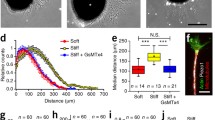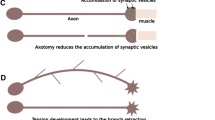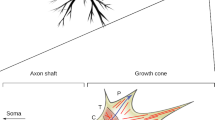Abstract
Mechanical tension is a robust regulator of axonal development of cultured neurons. We review work from our laboratory, using calibrated glass needles to measure or apply tension to chick sensory neurons, chick forebrain neurons, and rat PC12 cells. We survey direct evidence for two different regimes of tension effects on neurons, a fluid-like growth regime, and a nongrowth, elastic regime. Above a minimum tension threshold, we observe growth effects of tension regulating four phases of axonal development:
-
1.
Initiation of process outgrowth from the cell body;
-
2.
Growth cone-mediated elongation of the axon;
-
3.
Elongation of the axon after synaptogenesis, which normally accommodates the skeletal growth of vertebrates; and
-
4.
Axonal elimination by retraction.
Significantly, the quantitative relationship between the force and the growth response is suprisingly similar to the simple relationship characteristic of Newtonian fluid mechanical elements: elongation rate is directly proportional to tension (above the threshold), and this robust linear relationship extends from physiological growth rates to far-above-physiological rates. Thus, tension apparently integrates the complex biochemistry of axonal elongation, including cytoskeletal and membrane dynamics, to produce a simple “force input/growth output” relationship. In addition to this fluid-like growth response, peripheral neurons show elastic behaviors at low tensions (below the threshold tension for growth), as do most cell types. Thus, neurites could exert small static forces without diminution for long periods. In addition, axons of peripheral neurons can actively generate modest tensions, presumably similar to muscle contraction, at tensions near zero. The elastic and force-generating capability of neural axons has recently been proposed to play a major role in the morphogenesis of the brain.
Similar content being viewed by others
References
Weiss, P. (1941) Nerve Pattern: The mechanics of nerve growth.Growth (Suppl. Third Growth Symp.) 5, 163–203.
Landis, S. C. (1983) Neuronal growth cones.Ann. Rev. Physiol. 45, 567–580.
Purves D. and Lichtman, J. W. (1985)Principles of Neural Development. Sinauer, Sunderland, MA.
Bray, D. (1979) Mechanical tension produced by nerve cells in tissue culture.J. Cell Sci. 37, 391–410.
Bray, D. (1984) Axonal growth in response to experimentally applied tension.Dev. Biol. 102, 379–389.
Heidemann, S. R., Landers, J. M., and Hamborg, M. A. (1981) Polarity orientation of axonal microtubules.J. Cell Biol. 91, 661–665.
Sharp, G. A., Weber, K., and Osborn, M. (1982) Centriole number and process formation in established neuroblastoma cells and primary dorsal root ganglion neurones.Eur. J. Cell Biol. 29, 97–103.
Hill, T. L. and Kirschner, M. W. (1982) Bioenergetic and kinetics of microtubule and actin filament assembly-disassembly.Int. Rev. Cytol. 78, 1–125.
Dennerll, T. J., Joshi, H. C., Steel, V. L., Buxbaum, R. E., and Heidemann, S. R. (1988) Tension and compression in the cytoskeleton: II Quantitative masurements.J. Cell Biol. 107, 665–674.
Lamoureux, P., Buxbaum, R. E., and Heidermann, S. R. (1989) Direct evidence that growth cones pull.Nature 340, 159–162.
Zheng, J., Lamoureux, P., Santiago, V., Dennerll, T., Buxbaum, R. E., and Heidemann, S. R. (1991) Tensile regulation of axonal elongation and initiation.J. Neurosci. 11, 1117–1125.
Lamoureux, P., Altun-Gultekin, Z. F., Lin, C., Wagner, J. A., and Heidemann, S. R. (1997) Rac is required for growth cone function but not neurite assembly.J. Cell Sci. 110, 635–641.
Chada, S., Lamoureux, P., Buxbaum, R. E., and Heidemann, S. R. (1997) Cytomechanics of neurite outgrowth from chick brain neurons.J. Cell Sci. 110, 1179–1186.
Greene, L. and Tischler, A. S. (1982) PC 12 Pheochromocytoma cultures in neurobiological research.Adv. Cell. Neurobiol. 3, 373–414.
Chambers, R. and Fell, H. B. (1931) Micro-operations of cells in tissue cultures.Proc. Roy. Soc. Lond. B 109, 380–403.
Francis, G. W., Fisher, L. R., and Gamble, R. A. (1987) Direct measurement of cell detachment force on single cells using a new electromechanical method.J. Cell Sci. 87, 519–523.
Harris, A. (1973) Location of cellular adhesions to solid substrata.Dev. Biol. 35, 97–114.
Kolega, J. (1986) Effects of mechanical tension on protrusive activity and microfilament and intermediate filament organization in an epidermal epithelium in culture.J. Cell Biol. 102, 1400–1411.
Smith, C. (1994) Cytoskeletal movements and substrate interactions during initiation of neurite outgrowth by sympathetic neurons in vitro.J. Neurosci. 14, 384–398.
O’Connor, T. P., Duerr, J. S. and Bentley, D. (1990) Pioneer growth cone steering decisions mediated by a single filopodial contact in situ.J. Neurosci. 10, 3935–3949.
Harrison, R. G. (1910) The outgrowth of the nerve fiber as a mode of cytoplasmic movmement.J. Exp. Zool. 9, 787–846.
Trinkaus, J. P. (1985) Further thoughts on directional cell movement during morphogenesis.J. Neurosci. Res.,13, 1–19.
Aletta, J. M. and Greene, L. A. (1988) Growth cone configuration and advance: a time- lapse study using video-enchanced differential interference contrast microscopy.J. Neurosci. 8, 1425–1435.
Goldberg, D. J. and Burmeister, D. W. (1986) Stages in axon formation: observation of growth of Aplysia axons in culture using video-enhanced contrast-differential interference contrast microscopy.J. Cell Biol. 103, 1921–1931.
Bray, D. (1987) Growth cones: do they pull or are they pushed?Trends Neurosci. 10, 431–434.
Heidemann, S. R., Lamoureux, P., and Buxbaum, R. E. (1990) Growth cone behavior and production of traction force.J. Cell Biol. 111, 1949–1957.
Heidemann, S. R., Lamoureux, P., and Buxbaum, R. E. (1991) On the cytomechanics and fluid dynamics of growth cone motility.J. Cell Sci. Suppl. 15, 35–44.
Elson, E. L. (1988) Cellular mechanics as an indicator of cytoskeletal structure and function.Ann. Rev. Biophys. Chem. 17, 397–430.
Kerst, A., Chmielewski, C., Livesay, C., Buxbaum, R. E., and Heidemann, S. R. (1990) Liquid crystal domains and thixotropy of F-actin suspensions.Proc. Natl. Acad. Sci. USA 87, 4241–4245.
Bray, D. (1991) Isolated chick neurons for the study of axonal growth inCulturing Nerve Cells (Banker, G. and Goslin, K., eds.), MIT, Cambridge, MA, pp. 119–135.
Bentley, D. and O’Connor, T. P. (1994) Cytoskeletal events in growth cone steering.Curr. Opin. Neurobiol. 4, 43–48.
Tanaka, E., Ho, T., and Kirschner, M. W. (1995) The role of microtubule dynamics in growth cone motility and axonal growth.J. Cell Biol. 128, 139–155.
Craig, A. M., Wyborski, R. J., and Banker, G. (1995) Preferential addition of newly synthesized membrane protein at axonal growth cones.Nature 375, 592–594.
Popov, S., Brown, A., and Poo, M-M. (1993) Forward plasma membrane flow in growing nerve processes.Science 259, 244–246.
Letourneau, P. C., Shattuck, T. A., and Ressler, A. H. (1987) “Pull” and “push” in neurite elongation: observations on the effects of different concentrations of cytochalasin B and taxol.Cell Motility Cytoskeleton 8, 193–209.
Marsh, L. and Letourneau, P. C. (1984) Growth of neurites without filopodial or lamellipodial activity in the presence of cytochalasin B.J. Cell Biol. 99, 2041–2047.
Cowan, W. M., Fawcett, J. W., O’Leary, D. D. M., and Stanfield, B. B. (1984) Regressive events in neurogenesis.Science 225, 1258–1265.
Bixby, J. L. (1981) Ultrastructural observations of synapse elimnation in neonatal rabbit skeletal muscle.J. Neurocytol. 10, 81–100.
Riley, D. A. (1981) Ultrastructural evidence for axon retraction during spontaneous elimination of polyneural innervation of the rat soleus muscle.J. Neurocytol. 10, 425–440.
Dennerll, T. J., Lamoureux, P., Buxbaum, R. E., and Heidemann, S. R. (1989) The cytomechanics of axonal elongation and retraction.J. Cell Biol. 109, 3073–3083.
Van Essen, D. C. (1997) A tension-based theory of morphogenesis and compact wiring in the central nervous system.Nature 385, 313–318.
Craig, A. M. and Banker, G. (1994) Neuronal polarity.Annu. Rev. Neurosci. 17, 267–310.
Buxbaum, R. E. and Heidemann, S. R. (1988) A thermodynamic model for force integration and microtubule assembly during axonal elongation.J. Theor. Biol. 134, 379–390.
Buxbaum, R. E. and Heidemann, S. R. (1992) An absolute rate theory model for tension control of axonal elongation.J. Theor. Biol. 155, 409–426.
Lamoureux, P., Zheng, J., Buxbaum, R. E., and Heidemann, S. R. (1992) A cytomechanical investigation of neurite growth on different culture surfaces.J. Cell Biol. 118, 655–661.
Author information
Authors and Affiliations
Corresponding author
Rights and permissions
About this article
Cite this article
Heidemann, S.R., Lamoureux, P. & Buxbaum, R.E. Cytomechanics of axonal development. Cell Biochem Biophys 27, 135–155 (1997). https://doi.org/10.1007/BF02738107
Issue Date:
DOI: https://doi.org/10.1007/BF02738107




